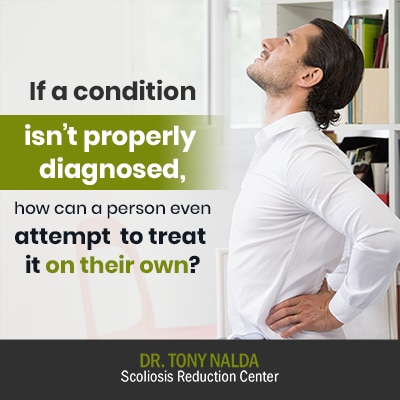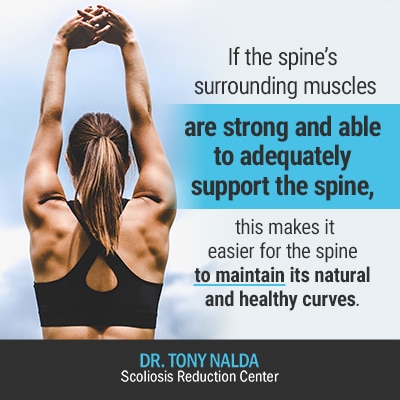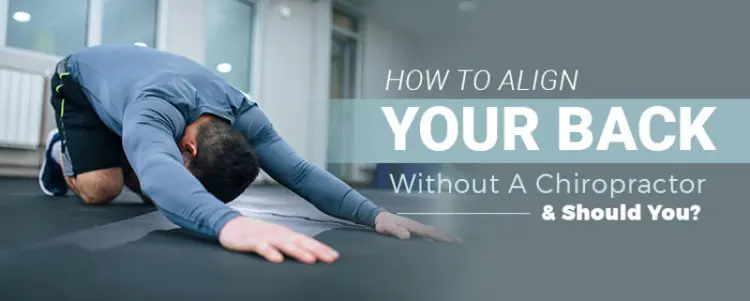While I support the choices of people being proactive with their health and trying more natural and non-invasive treatments for some medical issues, scoliosis is not one of them. As a structural issue, a spine that’s misaligned due to scoliosis needs more than just a general approach.
While there are exercises and stretches that help promote healthy spinal alignment through increasing core strength and can be done from home, once a spine’s misalignment is structural, as is the case with scoliosis, the condition has to be impacted on a structural level and monitored via X-ray.
While home exercises and stretches can bring some relief for people experiencing back pain, it can’t impact a structural condition, like scoliosis, on a structural level. Before we explore the risks of trying to align your back without a chiropractor, let’s first look at what it means to have a misaligned spine, and reasons people might be interested in self-treatment.
4 Key Takeaways
- Necessity of Professional Treatment for Scoliosis: Scoliosis, as a structural condition, requires treatment beyond general exercises and stretches. It demands a specific, structural approach, monitored through X-rays, to impact the condition meaningfully.
- Risks of Self-Aligning the Spine: Attempting to self-treat or align the spine without professional guidance can lead to further complications, especially for conditions like scoliosis that are beyond the scope of home exercises and can actually worsen without proper treatment.
- Importance of Understanding Spinal Conditions: Proper diagnosis and understanding of spinal conditions are crucial. Pain and symptoms can be misleading without a thorough examination and may lead to ineffective self-treatment efforts.
- Integrative Approach to Scoliosis Treatment: Scoliosis treatment at professional centers integrates chiropractic care, specialized exercises, and sometimes corrective bracing, focusing on reducing curvature and improving spinal biomechanics for long-term relief and structural improvement.
Spinal Alignment
The spine is made up of vertebrae (bones) that are stacked on top of one another, separated by intervertebral discs.
There are three main sections to the spine: cervical (neck), thoracic (middle and upper back), and lumbar (lower back). When a healthy spine is viewed from the side, it has a soft ‘S’ shape.
The reason the spine has an ‘S’ shape is because it has healthy curves that are characteristic of each spinal section. These curves work together to give the spine added strength, flexibility, and allow it to evenly distribute mechanical stress that’s incurred during movement.
When viewed from the back, a healthy spine should appear straight and run down the middle of the back.
When a spine becomes misaligned, there is a loss of its healthy curves as unnatural ones develop and the healthy curves can become under- or over-pronounced. There are many different spinal conditions that can lead to misalignment such as kyphosis, lordosis, and scoliosis.
Oftentimes, a spinal misalignment is evident in postural changes that give the body an overall asymmetrical affect.
When a spine becomes misaligned, people might be tempted to try and fix it themselves, and while there are proactive ways a person can relieve symptoms like pain from home, a professional chiropractor is needed to induce a structural change that addresses the underlying cause of the misalignment.
Before we move on, let’s first consider why some people might be interested in attempting to self-correct a spinal misalignment.
Why do People Choose Self-Treatment?
People making the choice to try and align their backs without a chiropractor do so for different reasons.
Some want to save themselves the time, money, and/or trip to the doctor’s office, and others are looking for more noninvasive methods.
Sometimes, people simply don’t understand the true source of their back pain and assume it’s something they can rectify on their own. Unfortunately, when this is not the case, not only will their self-treatment be unsuccessful, depending on the source of the pain, it can actually lead to more problems in the long run.
Risks of Attempting to Align Your Own Back
While a sore back and stiff muscles can benefit from some general DIY approaches to back-care through exercise, stretches, and what many people refer to as ‘cracking the back’ for relief, more serious structural issues like scoliosis need far more than just this general approach.
To be clear, the term ‘cracking the back’ is a colloquial expression that describes a person’s attempt to adjust their spine by applying pressure in an effort to bring relief; this is not an accurate chiropractic term.
When people attempt to ‘crack their own backs’, for example, what they are actually doing is releasing gas, and the effect is generally rotational in nature; the sound it makes isn’t the sound of vertebrae popping back into place or any structural change occurring, and in fact, it could be causing more harm than good.
The cracking or popping sound that people hear can be misleading, as many associate the sound itself with relief, but any relief it brings will be short-lived. Long-term relief can’t be achieved with rotational exercises alone; what’s truly needed is a chiropractor who knows which areas around the body need pressure applied to actually relax important muscles and reduce inflammation.
An attempt to align your own back could be potentially harmful if not consulting with a professional. There is always the risk of agitating a spine further, especially when someone isn’t aware of the cause of the spinal misalignment.
Even something that seems like it wouldn’t cause problems, like yoga, if not done correctly, can cause pain and potentially worsen the very symptoms a person is seeking relief from.
In addition, let’s think about how chiropractors diagnose and assess most spinal conditions: through comprehensive physical examinations and X-ray results. Unless a person has access to an X-ray machine at home, they have no way of definitively knowing what’s causing their back problems.

If a condition isn’t properly diagnosed, how can a person even attempt to treat it on their own?
Pain can be Misleading
Considering that pain is the most common back-related symptom that people are seeking relief from, it’s important to understand that where pain is felt isn’t necessarily its point of origin.
Often, people make the mistake of treating themselves by focusing on where their pain is felt, but this isn’t always an accurate approach.
Considering the spine works in tandem with the brain to form the body’s central nervous system (CNS), spinal conditions have the potential to cause numerous symptoms felt throughout the body.
A lot of pain related to spinal conditions involves pinched nerves caused by compression. Nerves are like branches on a tree, fanning off in multiple directions. A pinched nerve in the lower back, for example, can be felt as far away as in the feet.
For someone unaware of this, or who isn’t trained in how to determine the source of nerve pain and address it accordingly, they can be focusing their efforts on the wrong area entirely.
In addition, basing self-treatment mainly on pain is not addressing its underlying cause because as we know, pain is a symptom, not the condition itself.
The best way to definitively determine the cause of back pain is through a comprehensive physical exam conducted by a medical professional, who will likely recommend an X-ray if it’s deemed necessary.
Patients attempting self-treatment for a spinal misalignment run the risk of injuring themselves more seriously, and while this isn’t overly common, it is a risk that should be considered before taking matters into your own hands without professional guidance.
For those attempting self-treatment out of financial motivation, it can be disheartening to find that more money has to be spent to undo damage caused by self-treatment, or because a spinal condition has progressed while not being treated effectively.
The Risks of Treating Scoliosis at Home
Scoliosis is an abnormal sideways curvature of the spine that rotates.
As previously mentioned, there are some stretches and exercises that can be safely done from home to help strengthen the muscles charged with supporting and stabilizing the spine; in fact, at-home stretches and exercises are indeed a part of my treatment approach here at the Scoliosis Reduction Center®.
The important difference to understand is that when a condition is structural like scoliosis, those exercises and stretches not only have to be scoliosis-specific, treatment plans also have to be customized to account for individual patient/condition characteristics. In addition, exercises and stretches are only one component of the integrative treatment approach that scoliosis necessitates.
As a progressive condition, there are some potential dangers to self-treatment that are specific to scoliosis itself.
For example, if a person is trying to treat their back problems without a diagnosis and doesn’t realize they have scoliosis, valuable treatment time could be wasted. Remember, progressive conditions have it in their very nature to worsen over time.
I have seen this with a number of patients who have been trying to address their back pain at home, without understanding that as they are doing so, their scoliosis is progressing in severity and producing more noticeable symptoms throughout the self-treatment process.
It’s difficult to explain to these patients that had they come to me when they were first experiencing back pain, I could have diagnosed their spinal condition and started proactive treatment right away. Instead, we are now dealing with the complexities of treating a larger curvature that the body has had more time adjusting to.
Scoliosis is a structural condition, so any sustainable long-term relief from symptoms can only be achieved through impacting the condition’s underlying structural nature.
Scoliosis Reduction Center® Approach
Here at the Scoliosis Reduction Center®, we approach treating a misaligned spine through a functional chiropractic-centered approach. We customize every treatment plan to address the individual characteristics of each patient and their condition.
Scoliosis is a complex condition and ranges greatly in severity from mild to moderate, and severe to very severe. There are also many different forms of the condition that can develop: adolescent idiopathic scoliosis, neuromuscular scoliosis, degenerative scoliosis, congenital scoliosis, and traumatic scoliosis.
Each form has unique condition characteristics and treatment needs, but for someone attempting to treat their spinal misalignment at home, with or without an official diagnosis, the complexities of these different forms are simply too much to address without professional guidance.
In addition, here at the Center, we improve spinal alignment through an integrative approach so our patients benefit from multiple forms of treatment.
Through a combination of chiropractic care, in-office therapy, custom-prescribed home exercises, and specialized corrective bracing, we can effectively work towards a curvature reduction, restoring as much of the spine’s healthy curves as possible: improving the spine’s overall biomechanics. As this is achieved, the underlying cause of any related symptoms, such as postural changes and pain, are being addressed.
Even within the branch of chiropractic medicine, effective scoliosis treatment should be delivered by a chiropractor who is trained in multiple scoliosis-specific treatment modalities. Scoliosis-specific chiropractors don’t just know the spine, they understand scoliosis specifically.
So as we have discussed, the complex nature of scoliosis necessitates a highly-specific treatment approach that addresses both patient and condition characteristics; however, that’s not to say that there aren’t proactive steps a person can take on their own to protect the health of their spines at home, or to augment proactive treatment result delivered by a scoliosis chiropractor.
Proactive Steps to Promoting Spinal Health from Home
While we have spent a lot of time exploring the potential consequences of attempting to align your back without the help of a chiropractor, especially in terms of structural conditions like scoliosis, there are proactive steps a person can take to promote a healthy spine through increasing spinal flexibility, core strength, and prevention.
While the majority of scoliosis cases are idiopathic, meaning we can’t tie them to a specific causative source and, by extension, can’t prevent their onset, a healthy spine has numerous benefits, including preventing more general back problems.
In terms of prevention, we’ve all heard it before: movement is important not just for our spines, but our bodies overall. The very design of the spine is movement-oriented, so the best way to proactively promote spinal health is through an active and healthy lifestyle.
Movement is good for the spine because it helps keep it flexible, and when it comes to the intervertebral discs, movement helps keep them hydrated and replenished.
Movement also helps keep the muscles that surround the spine loose and strong, and this is important in terms of spinal alignment because those muscles help support and stabilize the spine.
In addition, bodies that are healthier and more fit respond better to treatment.
Practicing good posture is also a proactive means of protecting the health of the spine and promoting optimal spinal alignment. This includes preventing forward head posture, which can develop when a person spends a lot of time looking down at a device, increasing the weight of the head felt by the cervical spine and the muscles that support it.
Chronic bad posture can lead to a host of spinal conditions and issues, including what’s known as ‘functional scoliosis’; this isn’t true structural scoliosis because it can be corrected through movement and doesn’t include rotation.

If the spine’s surrounding muscles are strong and able to adequately support the spine, this makes it easier for the spine to maintain its natural and healthy curves.
As mentioned, home stretches and exercises can be beneficial in terms of keeping the spine and its surrounding muscles as loose and flexible as possible, and this can help promote a healthy spine in terms of strength, flexibility, and alignment.
Pelvic tilts, neck tilts, superman extensions, latissimus dorsi stretches, and squats can help protect a healthy spine’s alignment, and when combined with proactive scoliosis-specific chiropractic care, can help augment proactive treatment efforts.
Conclusion
Living in the DIY age, many are choosing to be more proactive with their health and care for themselves at home, rather than turning to medication and traditional medical treatment.
While this can bring positive results, especially in terms of preserving health through more natural and noninvasive means, certain conditions are simply too complex and necessitate specific forms of professional treatment.
This is especially the case when it comes to progressive conditions, like scoliosis, that are complex and structural in nature as they will get worse over time, if left untreated, or not treated effectively.
While healthy lifestyle habits, exercises, and stretches can have huge benefits in terms of preserving spinal mechanics and a healthy alignment, if back issues are related to a structural spinal condition like scoliosis, the condition needs to be addressed on a structural level, and this is beyond the scope of general self-treatment.
In addition, you don’t want to be wasting valuable treatment time trying to self-correct at home while your condition is progressing. People with scoliosis need proactive treatment and to be monitored via physical exams and X-ray.
A patient’s X-ray results tell us how severe their condition is, where along the spine the curvature is located, and whether the condition is considered typical (curve bending to the right, away from the heart), or atypical, with a curve that bends towards the heart.
X-rays are also an important means of observing how the spine is responding to treatment so we can adjust it accordingly, as the patient’s individual condition necessitates.
Here at the Scoliosis Reduction Center®, we work closely with our patients and engage them fully in the treatment process, and while exercises and stretches performed at home will be a part of our treatment plan, it’s only one component and can’t bring about a structural change on their own.
So should you align your back without a chiropractor? If you are looking for temporary relief from non-structural back issues, there are some safe and effective stretches and exercises that can help promote a healthy spine, including alignment; when a progressive structural condition like scoliosis is the cause, the answer is no, professional guidance from a scoliosis chiropractor is needed to bring about long-term sustainable change on a structural level.





